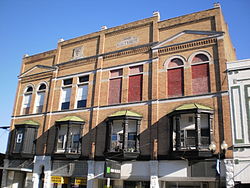Hartford City Courthouse Square Historic District | |
 One of the buildings on Main Street in the district | |
| Location | Roughly bounded by Franklin, Walnut, Water and Monroe Sts., Hartford City, Indiana |
|---|---|
| Coordinates | 40°27′5″N 85°22′5″W / 40.45139°N 85.36806°W |
| Area | 19 acres (7.7 ha) |
| Architect | Arthur LaBelle; Burt French; P.J. Loney; others |
| Architectural style | Italianate, Romanesque Revival, Renaissance Revival, Queen Anne, Art Deco |
| NRHP reference No. | 06000522[1] |
| Added to NRHP | June 21, 2006 |
The Hartford City Courthouse Square Historic District is located in Hartford City, Indiana. Hartford City has a population of about 7,000 and is the county seat of Blackford County and the site of the county courthouse. The National Park Service of the United States Department of the Interior added the Hartford City Courthouse Square Historic District to the National Register of Historic Places on June 21, 2006—meaning the buildings and objects that contribute to the continuity of the district are worthy of preservation because of their historical and architectural significance.[2][3] The District has over 60 resources, including over 40 contributing buildings, over 10 non-contributing buildings, one contributing object (a World War I statue), eight non-contributing objects, and two other buildings that are listed separately in the National Register.[4]
Much of the District's significance relates to the discovery of natural gas in the east central region of Indiana.[5] The discovery led to a regional economic boom known as the Indiana Gas Boom. Beginning in the late 1880s and lasting for about 15 years, the Gas Boom changed the economy and the appearance of the region.[6] The Hartford City Courthouse Square Historic District is situated in what was the center of Hartford City in the 19th and 20th centuries, and most of the buildings within the District were constructed during the Gas Boom era. The buildings within the District were built in several architectural styles, including Commercial Italianate, Romanesque Revival, Renaissance Revival, and others. Many of the buildings' exteriors have not been changed from their original appearance.[7]
- ^ "National Register Information System". National Register of Historic Places. National Park Service. March 13, 2009.
- ^ National Register of Historic Places List of Actions Taken on Properties 6/19/06 through 6/23/06 web page. Archived May 31, 2009, at the Wayback Machine
- ^ The National Register of Historic Places web site Archived November 6, 2012, at the Wayback Machine has a list of criteria for evaluation.
- ^ Hamilton, section 5. Although Hamilton describes exact counts for properties, those counts do not agree with Hamilton's map on page 25 of the Registration Form.
- ^ Hamilton, section 8, pages 12–13.
- ^ Glass, page 97.
- ^ Hamilton, section 7, pages 1–2.


